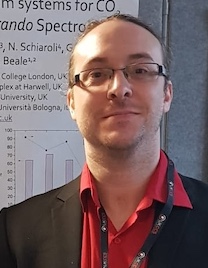There are many common questions in heterogeneous catalysis including what influence does porosity play? And, what is the catalyst actually doing under reaction conditions? While lab-based instruments can provide some insight, more nuanced answers often require the use of operando and in situ synchrotron characterisation techniques.
In this talk I will discuss two case studies from my recent work on applying synchrotron techniques to observe heterogeneous catalysts. One example will focus on the use of operando x-ray absorption spectroscopy (XAS) to probe the behaviour of metallic nanoparticles for CO2 hydrogenation, whilst another uses small angle neutron spectroscopy (SANS) to probe the porosity of hierarchically porous systems. In each case I’ll highlight the importance of having a specific question to answer, and the way synchrotron characterisation can advance catalytic science.
View recording of the presentation below:
Biography:

Matthew Potter was awarded a PhD from the University of Southampton in designing bifunctional heterogeneous catalysts in 2014. Since then, he has taken on numerous post-doctoral projects including at Georgia Institute of Technology (USA) where he investigated amine-based sorbents for CO2 capture, at the University of Southampton focussing on creating chemical reactors from photonic devices, and also on understanding active site design for nanocatalysts, as part of the TotalEnergies Consortium on nanocatalysts. From 2022-2023 Matt worked at UCL with Prof Andy Beale, based at the Harwell Campus on an ERC project, exploring the mechanism of CO2 hydrogenation catalysts using in situ and operando synchrotron techniques. In September 2023 Matt joined the University of Bath as a Prize Fellow in Sustainable Chemical Technologies, starting his independent career within the Department of Chemistry and the Institute for Sustainability. He is currently working in the fields of carbon utilisation, carbon capture, synchrotron characterisation and porous materials.




